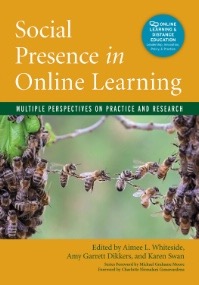online teaching
Select an item by clicking its checkbox

Teaching the World: Foundations for Online Theological Education
Date Reviewed: April 17, 2018
Teaching the World is a welcome volume on online theological education that seeks to ground educational practice with a theological foundation. The work is a critically needed guide that directs leaders and administers in developing online education programs. Readers will find practical insight on program development on three levels: framework, faculty, and classroom.
An introductory chapter entitled, “Past Patterns and Present Challenges in Online Theological Education,” describes the delivery of theological education from the early days of correspondence in the eighteenth century to the current practice of providing multimedia curricula fully online. After advocating the legitimacy of online theological education, the authors maintain that educational institutions have often not built their online programs on theological foundations. Instead, they have unwittingly overlooked this step in their rush to launch programs for primarily pragmatic reasons – increased enrollment and profitability.
The balance of the book is divided into three sections. Section I, “Better Foundations for Online Learning,” examines the role of the Pauline Epistles in theological education, ministry preparation, and spiritual formation from a distance. The authors argue that Paul\'s Epistolary practice provides biblical support for theological education from a distance and an example of how to deliver it. Subsequent pages integrate “social presence theory” with Paul\'s epistolary practice, resulting in a conceptual framework for online program development.
Section II, “Better Faculty for Online Learning,” provides theological guidance for faculty roles in online programs. Here the authors argue for faculty who: (1) emphasize the spiritual formation of students over the mere transfer of knowledge, (2) demonstrate the ability to leverage the medium of online education to accomplish the desired outcomes for students, and (3) model the theological and professional standards for ministry. In such an environment, online faculty members embody the values of the institution and effectively facilitate the desired outcomes of programs.
Section III, “Better Practices in the Classroom,” maintains that the students’ ministry contexts make effective online learning possible. Students in online programs are typically older and engaged in some form of ministry. Consequently, online programs should incorporate adult learning theory and facilitate learning in the student’s ministry context – the local church serving as an active partner in ministry preparation.
A concluding chapter, “To Teach, to Delight, and to Persuade,” argues that online programs are not a replacement for residential programs, but are a means for developing stronger partnerships for ministerial preparation. This book’s emphasis on using theology as a conceptual framework for online theological education is its conspicuous strength.
Teaching the World: Foundations for Online Theological Education presents a grand vision for online theological education that is particularly valuable for leaders of theological schools who seek to develop online programs that are effective in fulfilling the educational outcomes of their institutions.

Jump-Start Your Online Classroom: Mastering Five Challenges in Five Days
Date Reviewed: April 2, 2018
As a twenty-plus year veteran professor in a face-to-face classroom environment, I know to expect adjustments due to technological advances. These adjustments typically include learning to use new technologies and including them in your established and comfortable pedagogical practices. These adjustments are additions to your teaching norm. Now, with entire programs being converted to online interface, the norm shifts continually. With shifting norms in mind, I chose to review this book and actually apply its approach while converting one of my own classes to online delivery.
The brevity of Jump-Start Your Online Classroom should not be underestimated. Based on practical application of the content and concepts, its organization contains helpful hints on various aspects of successfully constructing a learner-centered, virtual classroom experience. The organization of the book is its greatest strength. Its five-day approach is based on five challenges: (1) Making the transition to online teaching, (2) Building online spaces for learning, (3) Preparing students for online learning, (4) Managing and facilitating the online classroom, and (5) Assessing learner outcomes.
One to three chapters are devoted to each of the five tasks and guide in confronting, conquering, and mastering each challenge. Embedded in the chapters are the almost clairvoyant voices of novice online instructors as well as online learners. Additionally, each chapter includes highlighted “Points to Remember” and ends with a section “For Reflection.” This reflection portion, if done in depth, makes the five-consecutive-day plan less realistic. The reflections may include assignments such as developing a communication or time management plan, an assessment of technology tools, or a careful consideration of your own teaching philosophy or pedagogical approach.
The fourth challenge, on classroom management, was especially helpful, as it contemplates interpersonal interaction and community building with people that may never meet. The section on teaching presence was especially helpful and thought-provoking. The authors use the analogy of the working parts of a car. For example, teaching presence is described as the “transmission component that allows us to set the pace, sequence, and activities that support and encourage students to work with materials and build their understanding of the content,” and also as the “timing belt that helps us manage learners, the dialogue, and the conditions for learning” (78). I understood those analogous functions even though I could not pick out either of those parts on an actual car! Challenge four also looks at dealing with group work and disgruntled students. The perspective of the novice online instructor underscored the importance of modeling the behavior that is required of the students.
Although this book is marketed toward the novice online instructor, its approach, organization, and content make it a foundational tool that could have long-term value in troubleshooting and future course design.
Time and time again, I find that successful online students are those with skills of self-direction, self-regulation, and time-management. Self-directed learners determine their learning needs, set learning goals, locate and access suitable resources for learning, manage their learning activities, monitor and evaluate their performance, and reflect on and reassess their ...

Social Presence in Online Learning - Multiple Perspectives on Practice and Research
Date Reviewed: December 12, 2017
As post-secondary institutions, theological schools continue to participate in various forms of online learning, and the criticism (or question), “It’s not really the same as being in a classroom with a real instructor” is commonly heard. The simple reply to this concern is the concept of social presence. Starting with the initial definition of social presence from Short, Williams, and Christies (1976), this compilation of articles attempts to summarize the historical perspectives and present the current state of discussion, recognizing the constant updating of online course options.
The authors successfully present the historical perspectives, grouping them in three broad categories – as technologically facilitated, as learners’ perceptions, and as critical literacy. However, the chronological and developmental approach leaves the reader realizing the earlier chapters have minimal application to current teachers and learners since the understanding of social presence and the technology used have changed so dramatically. The initial discussions about social presence whether through computer-mediated communication or later within the community of inquiry framework were informative, but the reader quickly realizes that the later frameworks and models have improved. Thus the earlier discussions in the book are of little value for today’s teaching-learning environment. In essence, only the last section is relevant, except as historical background.
The editors demonstrate their breadth of knowledge of the literature and are involved with and connected to the latest research in social presence. A useful chapter (11), “Cultural Perspectives in Social Presence,” provides valuable guidelines for communicating effectively in a multi-cultural learning context. Multiple examples explain how one subset of students find an online learning activity contributes positively to social presence while those of another culture find it impacts social presence negatively. Variations in anonymity, informal chat, self-disclosure, trust building, and conflict resolution are considered. The chapter concludes with useful tips for monitoring and mediating communication which could be misunderstood because of cultural differences.
Likewise, various practices for building social presence into discussions, feedback, and interactions are shared throughout the book. The literature reviewed includes a range of educational levels from K-12 and post-secondary as well as a range of disciplines. The final section provides interesting chapters (17 and 18) about the future of online learning and incorporates social presence into various models of instruction. They suggest social media tools enable instructors to incorporate cohesive and affective elements into courses to enhance social presence. The authors conclude, “Never stop learning because life never stops teaching” (210).
The information shared is relevant for any faculty member teaching online, including theological and religious studies professors. While the final chapters contain valuable tips as noted above, I cannot recommend the book as a whole since it is predominantly a historical overview of the concept of social presence. Though it contains various up-to-date strategies in the closing chapters, it was tedious for the reader to sift through the detailed literature for meaningful insights.
Best Practices in Online Teaching
Online Teaching: Best Practices (8:52)
This video summarizes 10 Best Practices for online teaching. What distinguishes the presenter’s approach is that she provides multiple ways to employ each individual practice.
How to Design Your Online Course (5:43)
Detailed discussion of how to apply 3 key principles of backward design to online teaching: Identify desired results, determine acceptable evidence (assessment), plan learning experiences and facilitation.
Online Classes: Tips for Success (10:48)
Engaging summary of what students like about online courses, why distraction challenges student learning online, factors that detract or contribute to online learning, and some ways to increase odds of success. Recommended for prospective online students as well as teachers.
Evaluating Discussion Boards (6:39)
Three professors describe the rubrics they use for grading contributions to discussion boards.
Using Blogs in Online Classes as a Learning Tool (10:52)
Why and how to use collaborative and “individual writing network” blogs as an alternative to discussion boards. The presenter suggests guidelines for integrating blogs into online teaching and enumerates the benefits she’s observed.
Creating an Interactive and Personal Course (8:22)
What student posts in discussion boards tell teachers and how to use this knowledge in “announcement links” to interact with the class. Other purposes of general comments from the instructor through these links are outlined as well. Presenter discusses the advantage of blogs over discussion boards for personal interaction with individual students.
VoiceThread in Online Courses (15:39)
A thorough introduction to using VoiceThread: what it is, benefits of using it, challenges it presents, and how to overcome them.
How Students Cheat (8:13)
Situates student behavior along a “continuum of cheating” and explains forms of cheating less commonly classified as such in order that professors can take steps to minimize these behaviors.
Using Weekly Video in Your Online Course (7:06)
A professor’s musings on why weekly video posts to students enhance online teaching and learning.
Group Discussions in Online Classes (6:23)
Strategies for stimulating online small-group discussion of readings and presentations.
